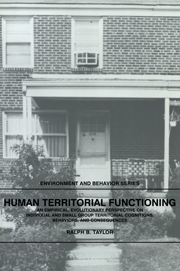 Human Territorial Functioning
Human Territorial Functioning Book contents
- Frontmatter
- Contents
- List of figures, tables, and boxes
- Series foreword
- Preface
- Acknowledgments
- 1 Introduction
- PART I ORIGINS OF HUMAN TERRITORIAL FUNCTIONING
- PART II A CONCEPTUAL MODEL OF HUMAN TERRITORIAL FUNCTIONING
- PART III TERRITORIAL FUNCTIONING IN SETTINGS OF VARYING CENTRALITY
- PART IV APPLICATIONS TO SOCIAL PROBLEMS
- PART V REVIEW AND PROSPECTS
- Index
- Frontmatter
- Contents
- List of figures, tables, and boxes
- Series foreword
- Preface
- Acknowledgments
- 1 Introduction
- PART I ORIGINS OF HUMAN TERRITORIAL FUNCTIONING
- PART II A CONCEPTUAL MODEL OF HUMAN TERRITORIAL FUNCTIONING
- PART III TERRITORIAL FUNCTIONING IN SETTINGS OF VARYING CENTRALITY
- PART IV APPLICATIONS TO SOCIAL PROBLEMS
- PART V REVIEW AND PROSPECTS
- Index
Summary
In recent decades the relationship between human behavior and the physical environment has attracted researchers from the social sciences – psychology, sociology, geography, and anthropology – and from the environmental-design disciplines – architecture, urban and regional planning, and interior design. What is in many respects a new and exciting field of study has developed rapidly. Its multidisciplinary character has led to stimulation and cross–fertilization, on the one hand, and to confusion and difficulty in communication, on the other. Those involved have diverse intellectual styles and goals. Some are concerned with basic and theoretical issues; some, with applied real–world problems of environmental design.
This series offers a common meeting ground. It consists of short books on different topics of interest to all those who analyze environmentbehavior links. We hope that the series will provide a useful introduction to the field for students, researchers, and practitioners alike, and will facilitate its evolutionary growth as well.
- Type
- Chapter
- Information
- Human Territorial FunctioningAn Empirical, Evolutionary Perspective on Individual and Small Group Territorial Cognitions, Behaviors, and Consequences, pp. xxi - xxiiPublisher: Cambridge University PressPrint publication year: 1988


